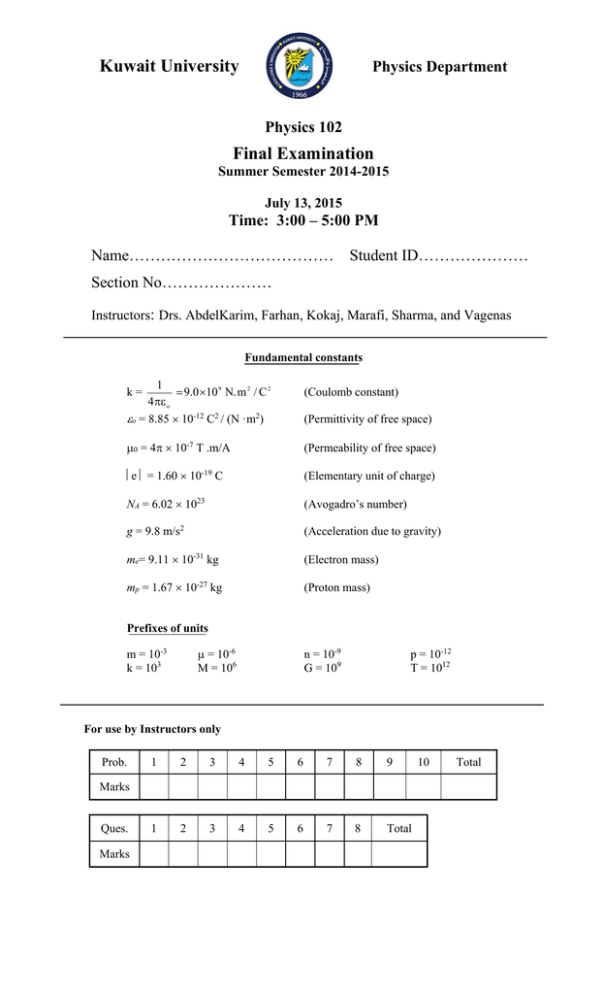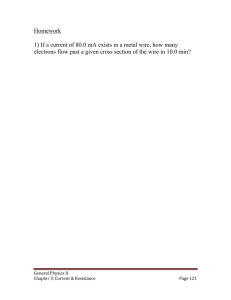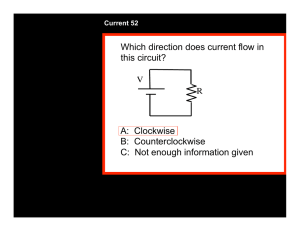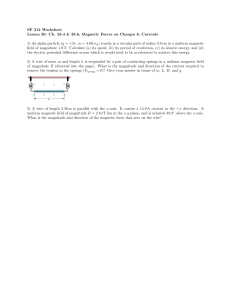Kuwait University Final Examination - eng
advertisement

Kuwait University Physics Department Physics 102 Final Examination Summer Semester 2014-2015 July 13, 2015 Time: 3:00 – 5:00 PM Name………………………………… Student ID………………… Section No………………… Instructors: Drs. AbdelKarim, Farhan, Kokaj, Marafi, Sharma, and Vagenas Fundamental constants k= 1 9.0 10 9 N. m 2 / C 2 4 (Coulomb constant) o = 8.85 10-12 C2 / (N·m2) (Permittivity of free space) 0 = 4 10-7 T .m/A (Permeability of free space) e = 1.60 10-19 C (Elementary unit of charge) NA = 6.02 1023 (Avogadro’s number) g = 9.8 m/s2 (Acceleration due to gravity) me= 9.11 10-31 kg (Electron mass) mp = 1.67 10-27 kg (Proton mass) Prefixes of units = 10-6 M = 106 m = 10-3 k = 103 n = 10-9 G = 109 p = 10-12 T = 1012 For use by Instructors only Prob. 1 2 3 4 5 6 7 8 9 1 2 3 4 5 6 7 8 Total Marks Ques. Marks 10 Total PART I: Solve all the problems. Show your solutions in detail. 1. Three point charges (Q1 = +3 C, Q2 = +2 C and Q3 = -5 C) are placed as shown. Find the net force, ܨԦ௧ , on Q3. [4 points] Q2 3m ܨԦଶଷ ܨԦଵଷ Q3 4m Q1 2. Three charged particles are placed at the corners of a right-angle triangle as shown in the figure. What is the magnitude of the electric field at point P? Given, Q = 15 nC, and a = 40 cm. [3 points] +2Q r P a r Q r a +2Q 3. A charge of 45 nC is distributed uniformly throughout a cubical volume of 5 cm side. Determine the electric flux through the surface of a spherical volume of 3 mm radius completely within the cubical shape. [3 points] 5cm 5cm 5cm Qenl Vsphere Q 4 4 (3 10 3 )3 Qenl (3 10 3 )3 Vcube 3 3 45 10 9 4 (3 10 3 )3 Qenl 40.7 10 12 C Qenl 2 3 (5 10 ) 3 Qenl 0 4.60 Nm 2 / C 4. Two concentric spherical conductors of radii a = 5 cm and b = 7 cm carry charges Qa and Qb, respectively. If Qa = +4 nC and the potential at the center relative to infinity is -900 V, determine the charge Qb. [3 points] Qb VO Va Vb Q Q 900V k a k b a b 9 Qb 9 (4 10 ) 9 10 9 900V 9 10 2 5 10 7 10 2 Qb 900V 720V 9 10 9 7 10 2 Qb 12.6 nC Qa a b 5. An isolated 240 F air-filled parallel-plate capacitor is charged to 160 C. If a dielectric material (K = 3.2) is inserted filling one third of the space between the plates, as shown. Calculate the change in the potential energy of the system. [4 points] 2A / 3 2 A 2 0 Ci d 3 d 3 A/3 1 A 3.2 C 0 0 Ci d d 3 3 C f Cair C C f 1.73Ci Cair 0 1 Q2 1 Q2 1 Q2 U U f U i U U i U 2 Cf 2 (1.73Ci ) 2 Ci 1 Q2 1 U 1 U 22.5 J 2 Ci 1.73 6. In the circuit shown the current in the 2 resistor is 2 A in the direction indicated. Find the value of the emf . [3 points] 5Ω Ι1 12V ε 2Ω I=2A Right loop : 2 2 12 1 I 2 0 I 2 8A Junction rule : I1 I I 2 I1 6A Left loop : 5 6 12 2 2 0 38V Ι2 1Ω 7. A copper cable of length 16 m (resistivity = 1.7x10-8 .m) carrying a current of 50 A loses energy at a rate of 0.08 W. Calculate the radius of the cable. P RI 2 rI [2 points] L 2 I r 2 16 L 50 1.7 x10 8 0.052 m P 0.08 8. The switch is closed for a long time so that the steady state is reached. At t = 0 s the switch is opened. What is the current in the R2 resistor at t = 4.00 ms. Given ε = 20.0V, R1 = 10.0 kΩ, kΩ, C = 0.400 µF. [4 points] ε R2 R1 q(t) Q e t R2C R2C 20V (15 10 3 )(0.400 10 6 ) Q Q C Q 4.8 10 6 C 3 R1 R2 (10 15) 10 t t dq d R2C R2C i(t) i(t) Q e i(t) R R e dt dt 1 2 410 3 20 (1510 3 )(0.40010 6 ) i(t) e A i(t) 4.11 10 4 A 3 (10 15) 10 R2 = 15.0 C 9. A wire of the shape shown in the figure lies in the xy-plane in a uniform magnetic field B = 0.80 T. If the wire carries a current I = 5 A, what is the magnitude and direction of the net magnetic force on the wire? Given, L = 0.20 m. [3 points] y L B I 45° 45° x 10. Two long straight wires are perpendicular to the page and separated by a distance x1 = 0.75 cm. Wire 1 carries current 6.5 A into the page. What are the magnitude and the direction of the current in wire 2 if the net magnetic field due to the two currents is zero at point P located at distance cm. x2 = 1.50 [3 points] Wire 1 Wire 2 x2 x1 P PART II: Multiple Choice Questions (each carries 1 point). Tick the best answer 1. Three identical conducting spheres A, B, and C initially have charges of +8Q, +4Q, and −8Q, respectively. Thin conducting wire connects two balls at a time in the following sequence: (1) balls A and B, then (2) balls A and C. The final charge on ball A is: (a) zero (b) −Q (c) −4Q (d) −8Q. 2. In the figure below, two points A and B are located within a region in which there is an electric field. The potential difference ΔV = VB – VA is ܧሬԦ (a) zero B (b) positive A (c) negative (d) Dependent on the magnitude of the electric field. 3. The graphs below show the electric field of a positively charged conducting sphere. The solid lines represent the electric field lines and the dashed ones the equipotential surfaces. Which graph is correct? +Q +Q +Q (a) 4. (b) +Q (d) (c) Three identical light bulbs are connected to a battery as shown. If the switch S is opened, which statement is correct? (a) Bulb 2 becomes dimmer and bulb 3 becomes brighter. (b) Bulb 2 and 3 become brighter. (c) Bulb 2 and 3 become dimmer. 2 (d) Bulb 2 and 3 light the same as before. 1 3 5. In the arrangements below, all wires are equally spaced and carry equal currents directly into or out of the page. In which arrangement the net force is zero on the central wire due to the currents in the other wires? (a) (b) (c) (d) 6. The capacitor is uncharged and the switch is open. At instant t = 0, we close the switch. The initial current, Io, through resistor R2 is R1 (a) 0 (b) Io = V/ R1 R2 C (c) Io = V/ R2 (d) Io = V/ (R1 + R2) V 7. Four charged particles with identical masses and velocities are entering and leaving the region of uniform magnetic field, as shown in the figure. Which particle has the smallest charge? (a) Particle 1 1 (b) Particle 2 (c) Particle 3 2 (d) Particle 4 3 4 ሬሬԦ 8. A long, straight wire carries an electric current directed into the page. If B0 is the magnitude of magnetic field due to the current at point A, what is the magnitude of the field at point C? (a) B0 (b) B0 / 2 (c) B0 / 4 (d) B0 / 16 A a C a a a a






